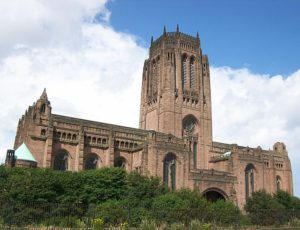When you think of Liverpool’s culture, you may first consider the area’s musical tradition and unintelligible accent. Architecture might not be the most immediate thing that comes to mind, but Anish Kapoor is planning on drawing attention to one of the city’s great buildings.
Liverpool Cathedral is the largest church in Britain, the eighth largest in the world, surpassing even the Florence Duomo, Saint Paul’s Cathedral, and the Sagrada Familia. However, unlike many major British churches, Liverpool Cathedral is a relatively new structure. While Lincoln Cathedral and Westminster Abbey have their roots in the medieval period, construction on Liverpool Cathedral first started in 1904. Liverpool has been one of Britain’s most important places for centuries, but it was only elevated to city status and became its own diocese in 1880. Therefore, the city had no cathedral but used a parish church called Saint Peter’s as its ecclesiastical center. The architects scheduled the cathedral’s completion for 1940. However, both world wars deprived the project of materials and a workforce. In addition, German bombing campaigns damaged part of the building, which was not fully repaired until 1955. The cathedral was finally completed in 1978.
Anish Kapoor is known as an innovator in the world of sculpture and installation art. His work can be seen throughout the globe, most famously the Cloud Gate in Chicago (known colloquially as The Bean) and the Orbit Tower in East London, built for the 2012 Olympic Games. He’s been awarded the Turner Prize and a knighthood for his work, among many other accolades. Now, he is bringing his large-scale installations to Liverpool for the centenary of the cathedral’s consecration. Between August 10th and September 15th, the cathedral will host an exhibition called Monadic Singularity; the artist’s first major solo exhibit in Liverpool since 1983. The show is named after one of the works that will be on display, a 2015 sculpture made from PVC and steel called Sectional Body Preparing for Monadic Singularity (this installation and five others by Kapoor were actually on display in the gardens of Versailles when I visited in the summer of 2015).
Featured will be a selection of works by Kapoor from over the last twenty-five years, some of them making their British debut; all of which were selected for their connection to themes such as life, death, and birth. In a way, the exhibition will not only display Kapoor’s work, but the work itself will also participate in a dialogue with the cathedral. It actually seems rather fitting that Kapoor will exhibit these pieces in a cathedral since it is a place where death and rebirth are ritualized at every mass. Furthermore, the work will likely stand out against the building’s stone, built according to Gothic revival designs. Organizers are planning for Kapoor’s installations to be placed in the nave, the Lady Chapel, and in the ambulatories. Elisa Nocente, the cathedral’s head of cultural programme, described Kapoor’s art as provoking “both wonder and uneasiness”. With one of Britain’s most important contemporary artists contributing to the celebrations, Liverpool Cathedral’s centenary seems to be one of Britain’s biggest cultural events this year.

